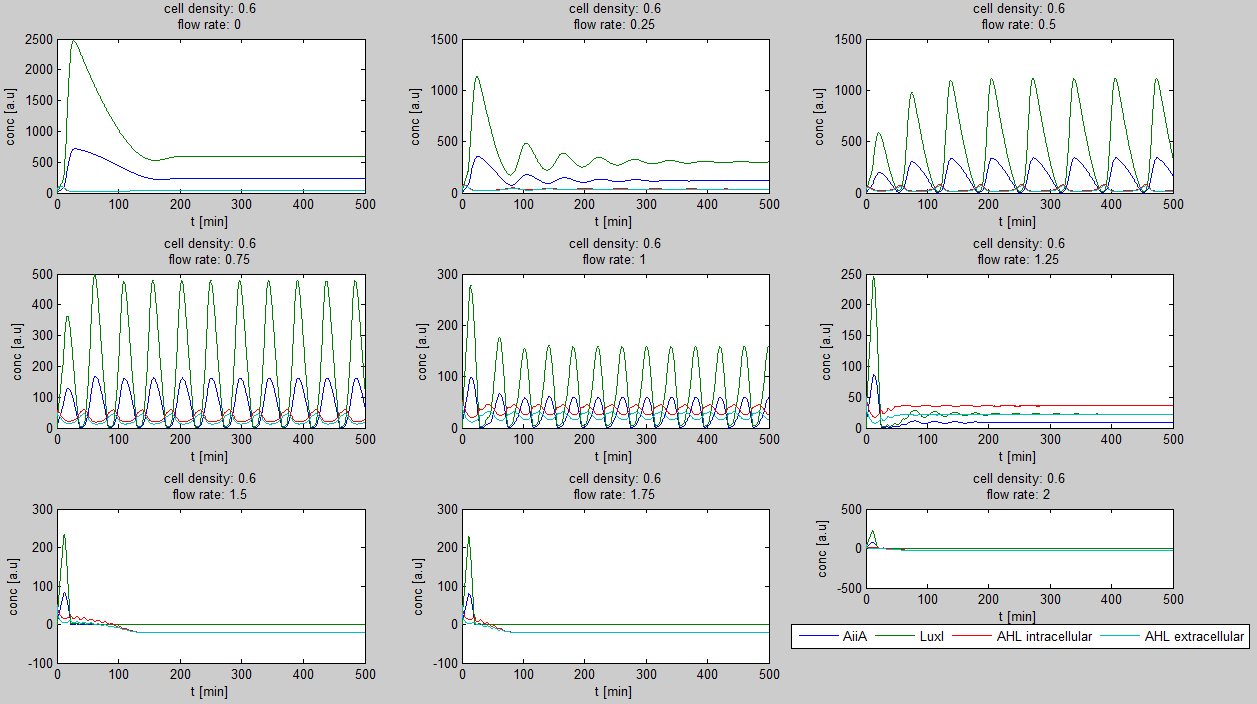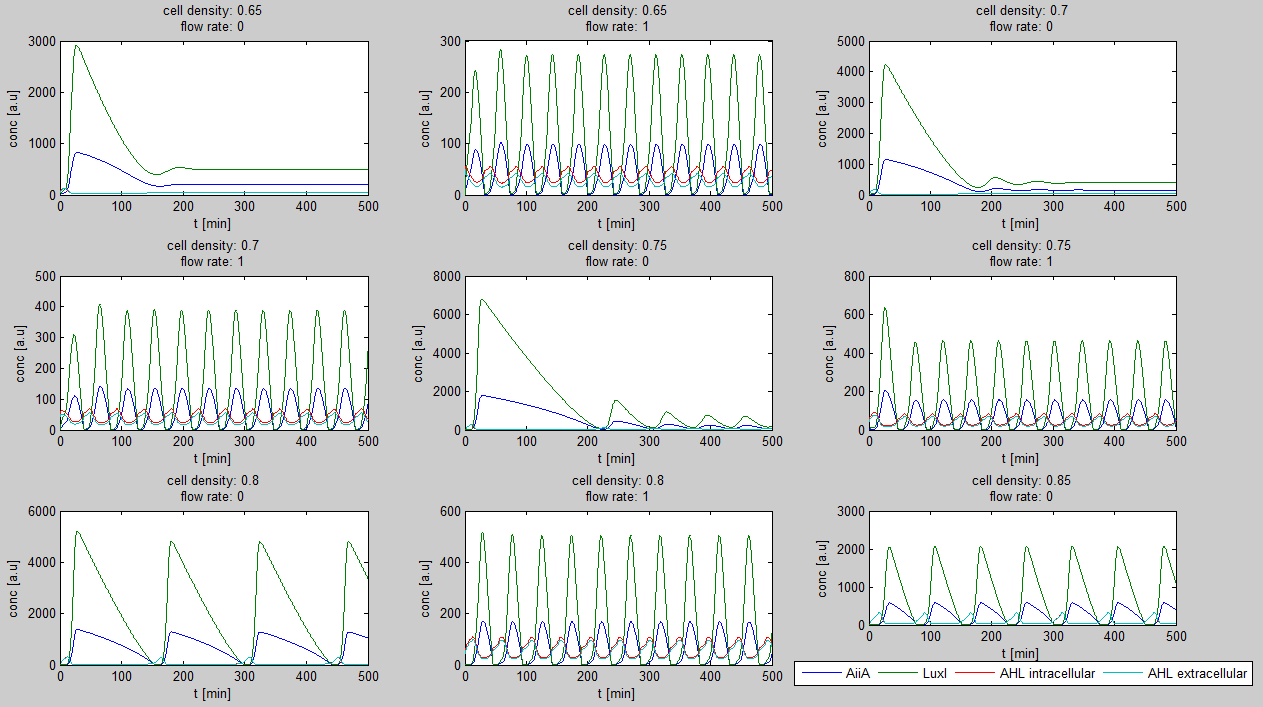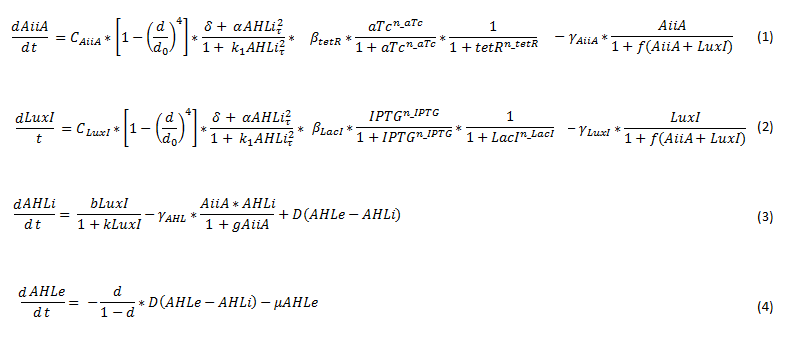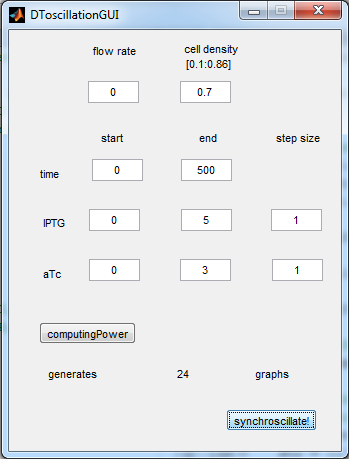Team:Wageningen UR/Project/ModelingProj1
From 2011.igem.org
(→Modeling synchronized oscillations) |
(→Modeling synchronized oscillations) |
||
| Line 84: | Line 84: | ||
=== Writing a modeling tool in Matlab === | === Writing a modeling tool in Matlab === | ||
| + | |||
| + | <!-- | ||
[[File:Oscillation_GUI_WUR.png|center]] | [[File:Oscillation_GUI_WUR.png|center]] | ||
'''Fig.1:''' ''GUI of the Matlab modeling tool created by team Wageningen UR'' | '''Fig.1:''' ''GUI of the Matlab modeling tool created by team Wageningen UR'' | ||
| + | |||
| + | --> | ||
For the first simulations, the same parameters were used as in the cited paper. The only variables thus being the cell density and flow rate. To get an idea about the different conditions in which oscillations could occur, our team created a script for a Matlab modeling tool which uses nested for-loops to vary the flow rate and cell density over a range of values. The resulting tool allows the user to enter the range in which the variables should be varied. The tool then iterates over the values and plots graphs of all combinations possible for that range of values. Figure 2 shows an example output of the tool. | For the first simulations, the same parameters were used as in the cited paper. The only variables thus being the cell density and flow rate. To get an idea about the different conditions in which oscillations could occur, our team created a script for a Matlab modeling tool which uses nested for-loops to vary the flow rate and cell density over a range of values. The resulting tool allows the user to enter the range in which the variables should be varied. The tool then iterates over the values and plots graphs of all combinations possible for that range of values. Figure 2 shows an example output of the tool. | ||
| Line 117: | Line 121: | ||
To model the [[Team:Wageningen_UR/Project/CompleteProject1Description#Designs| double tunable oscillator]], the original set of delay differential equations was expanded. This involved adding the effect of the repressor and activator in the form of a Hill function to the differential equations for LuxI and AiiA. The equations for the internal and external AHL concentrations were not changed. The new set of equations is seen below. | To model the [[Team:Wageningen_UR/Project/CompleteProject1Description#Designs| double tunable oscillator]], the original set of delay differential equations was expanded. This involved adding the effect of the repressor and activator in the form of a Hill function to the differential equations for LuxI and AiiA. The equations for the internal and external AHL concentrations were not changed. The new set of equations is seen below. | ||
| + | [[File:Equations_enhanced_WUR.png]] | ||
'''Top: ''Adjusted set of differential equations for the double tunable oscillator'' | '''Top: ''Adjusted set of differential equations for the double tunable oscillator'' | ||
| - | Since the lacI repressed hybrid promoter used for this system was designed by the Tokyo iGEM 2007 team [3], the | + | Since the lacI repressed hybrid promoter used for this system was designed by the Tokyo iGEM 2007 team [3], the additional terms were derived according to their model. The tetR repressor was then modeled using the same template. |
This set of equations was then used to write a new matlab modeling tool, of which the GUI is depicted below. | This set of equations was then used to write a new matlab modeling tool, of which the GUI is depicted below. | ||
| - | [[File:GUI_2_synchroscillator_WUR.png|center]] | + | [[File:GUI_2_synchroscillator_WUR.png|300px|center]] |
As can be seen in the GUI, the new variables which can be changed are now the both activators IPTG and aTc. The parameters used are still in arbitrary units and the values not yet verified with wet lab experiments. However, some | As can be seen in the GUI, the new variables which can be changed are now the both activators IPTG and aTc. The parameters used are still in arbitrary units and the values not yet verified with wet lab experiments. However, some | ||
Revision as of 19:17, 21 September 2011
 "
"






